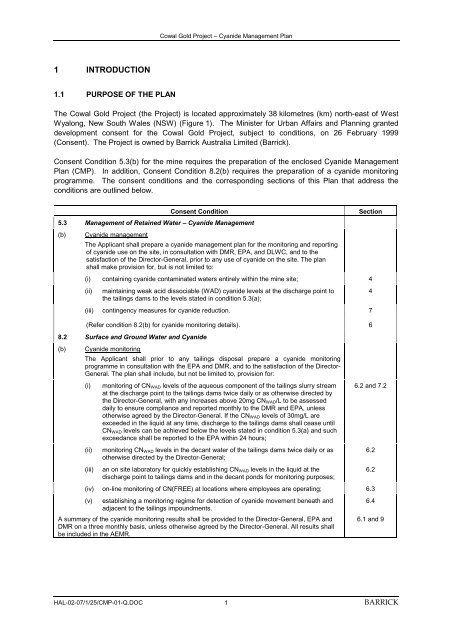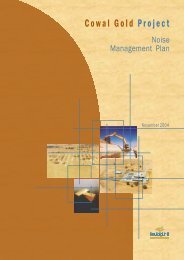January 2006 (PDF 2.9 MB) - Barrick Gold Corporation
January 2006 (PDF 2.9 MB) - Barrick Gold Corporation
January 2006 (PDF 2.9 MB) - Barrick Gold Corporation
You also want an ePaper? Increase the reach of your titles
YUMPU automatically turns print PDFs into web optimized ePapers that Google loves.
1 INTRODUCTION<br />
1.1 PURPOSE OF THE PLAN<br />
Cowal <strong>Gold</strong> Project – Cyanide Management Plan<br />
The Cowal <strong>Gold</strong> Project (the Project) is located approximately 38 kilometres (km) north-east of West<br />
Wyalong, New South Wales (NSW) (Figure 1). The Minister for Urban Affairs and Planning granted<br />
development consent for the Cowal <strong>Gold</strong> Project, subject to conditions, on 26 February 1999<br />
(Consent). The Project is owned by <strong>Barrick</strong> Australia Limited (<strong>Barrick</strong>).<br />
Consent Condition 5.3(b) for the mine requires the preparation of the enclosed Cyanide Management<br />
Plan (CMP). In addition, Consent Condition 8.2(b) requires the preparation of a cyanide monitoring<br />
programme. The consent conditions and the corresponding sections of this Plan that address the<br />
conditions are outlined below.<br />
Consent Condition Section<br />
5.3 Management of Retained Water – Cyanide Management<br />
(b) Cyanide management<br />
The Applicant shall prepare a cyanide management plan for the monitoring and reporting<br />
of cyanide use on the site, in consultation with DMR, EPA, and DLWC, and to the<br />
satisfaction of the Director-General, prior to any use of cyanide on the site. The plan<br />
shall make provision for, but is not limited to:<br />
(i) containing cyanide contaminated waters entirely within the mine site; 4<br />
(ii) maintaining weak acid dissociable (WAD) cyanide levels at the discharge point to<br />
the tailings dams to the levels stated in condition 5.3(a);<br />
(iii) contingency measures for cyanide reduction. 7<br />
(Refer condition 8.2(b) for cyanide monitoring details). 6<br />
8.2 Surface and Ground Water and Cyanide<br />
(b) Cyanide monitoring<br />
The Applicant shall prior to any tailings disposal prepare a cyanide monitoring<br />
programme in consultation with the EPA and DMR, and to the satisfaction of the Director-<br />
General. The plan shall include, but not be limited to, provision for:<br />
(i) monitoring of CNWAD levels of the aqueous component of the tailings slurry stream<br />
at the discharge point to the tailings dams twice daily or as otherwise directed by<br />
the Director-General, with any increases above 20mg CNWAD/L to be assessed<br />
daily to ensure compliance and reported monthly to the DMR and EPA, unless<br />
otherwise agreed by the Director-General. If the CNWAD levels of 30mg/L are<br />
exceeded in the liquid at any time, discharge to the tailings dams shall cease until<br />
CNWAD levels can be achieved below the levels stated in condition 5.3(a) and such<br />
exceedance shall be reported to the EPA within 24 hours;<br />
(ii) monitoring CNWAD levels in the decant water of the tailings dams twice daily or as<br />
otherwise directed by the Director-General;<br />
(iii) an on site laboratory for quickly establishing CNWAD levels in the liquid at the<br />
discharge point to tailings dams and in the decant ponds for monitoring purposes;<br />
HAL-02-07/1/25/CMP-01-Q.DOC 1 BARRICK<br />
4<br />
6.2 and 7.2<br />
(iv) on-line monitoring of CN(FREE) at locations where employees are operating; 6.3<br />
(v) establishing a monitoring regime for detection of cyanide movement beneath and<br />
adjacent to the tailings impoundments.<br />
A summary of the cyanide monitoring results shall be provided to the Director-General, EPA and<br />
DMR on a three monthly basis, unless otherwise agreed by the Director-General. All results shall<br />
be included in the AEMR.<br />
6.2<br />
6.2<br />
6.4<br />
6.1 and 9

















